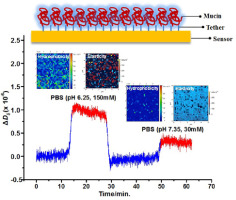当前位置:
X-MOL 学术
›
Acta Biomater.
›
论文详情
Our official English website, www.x-mol.net, welcomes your feedback! (Note: you will need to create a separate account there.)
A free-floating mucin layer to investigate the effect of the local microenvironment in lungs on mucin-nanoparticle interactions.
Acta Biomaterialia ( IF 9.7 ) Pub Date : 2020-01-13 , DOI: 10.1016/j.actbio.2020.01.014 Feng Wan 1 , Mikkel Herzberg 2 , Zheng Huang 1 , Tue Hassenkam 3 , Hanne M Nielsen 1
Acta Biomaterialia ( IF 9.7 ) Pub Date : 2020-01-13 , DOI: 10.1016/j.actbio.2020.01.014 Feng Wan 1 , Mikkel Herzberg 2 , Zheng Huang 1 , Tue Hassenkam 3 , Hanne M Nielsen 1
Affiliation

|
Respiratory tract mucus represents an important barrier for pulmonary drug delivery. Understanding of mucin-nanoparticle interactions is a prerequisite for rational design of inhalable nanoparticles. In the present study, in order to establish a reliable quartz crystal microbalance with dissipation (QCM-D) approach to reveal the effect of the lung microenvironment on the mucin-nanoparticle interactions, we investigated the intrinsic features of the mucin layers immobilized onto sensors via chemical conjugation or physical adsorption by using atomic force microscopy (AFM) and QCM-D. Our results demonstrated that the covalently-grafted mucin layer responded more sensitively than the physically-adsorbed mucin layer to the local microenvironment shifting from PBS (pH 7.35 and ionic strength 30 mM) to PBS (pH 6.25 and ionic strength 150 mM) and resulted in a softer mucin layer with more hydrophobic areas exposed. Furthermore, using the QCM-D approach with the covalently-grafted mucin layer, we demonstrated the significant influence of the local microenvironment on the interaction of mucin with poly (lactic-co-glycolic acid)-based nanoparticles with different surface hydrophilicity. The present work underlines the QCM-D approach with a covalently-grafted mucin layer as a potent tool to elucidate the potential influence of local microenvironment on mucin-nanoparticle interactions. STATEMENT OF SIGNIFICANCE: Studying interactions between nanoengineered materials and biological systems plays a vital role in development of biomedical applications of nanoengineered materials. In this work, by employing a more biologically relevant, 'free-floating' mucin layer model, we demonstrate the significant impact of the lung microenvironment on the nature and the extent of the interaction between the mucin and the nanoparticles with different surface hydrophilicity. To the best of our knowledge, this is the first work describing the nanoscale properties of immobilized mucin layers and investigating the mucin-nanoparticle interactions with emphasis on the impact of local microenvironment in lungs. Thus, it is expected to have important consequences in rational design of inhalable nanoparticle delivery systems.
中文翻译:

一个自由浮动的粘蛋白层,用于研究肺中局部微环境对粘蛋白-纳米颗粒相互作用的影响。
呼吸道粘液代表了肺部药物输送的重要障碍。了解黏蛋白-纳米颗粒的相互作用是合理设计可吸入纳米颗粒的前提。在本研究中,为了建立可靠的耗散石英晶体微天平(QCM-D)方法来揭示肺微环境对粘蛋白-纳米颗粒相互作用的影响,我们研究了通过固定在传感器上的粘蛋白层的固有特征。使用原子力显微镜(AFM)和QCM-D进行化学共轭或物理吸附。我们的结果表明,与物理吸附的粘蛋白层相比,共价移植的粘蛋白层对从PBS(pH 7.35和离子强度30 mM)转变为PBS(pH 6)的局部微环境的反应更为敏感。25离子强度和150 mM的离子强度),并得到更柔软的粘蛋白层,并暴露了更多的疏水区域。此外,将QCM-D方法与共价接枝的粘蛋白层一起使用,我们证明了局部微环境对粘蛋白与具有不同表面亲水性的基于聚(乳酸-乙醇酸)的纳米颗粒之间的粘蛋白的相互作用具有重大影响。本工作强调了QCM-D方法,以共价移植的粘蛋白层作为有效的工具来阐明局部微环境对粘蛋白-纳米颗粒相互作用的潜在影响。意义声明:研究纳米工程材料与生物系统之间的相互作用在纳米工程材料的生物医学应用开发中起着至关重要的作用。在这项工作中,通过采用更具生物学意义的“自由浮动” 在粘蛋白层模型中,我们证明了肺微环境对粘蛋白与具有不同表面亲水性的纳米颗粒之间相互作用的程度和性质的重大影响。据我们所知,这是描述固定化粘蛋白层的纳米级特性并研究粘蛋白-纳米颗粒相互作用(着重于肺部局部微环境的影响)的第一项工作。因此,预期在可吸入纳米颗粒递送系统的合理设计中将具有重要的结果。这是描述固定化粘蛋白层的纳米级特性并研究粘蛋白-纳米颗粒相互作用(着重于肺部局部微环境的影响)的第一项工作。因此,预期在可吸入纳米颗粒递送系统的合理设计中将具有重要的结果。这是描述固定化粘蛋白层的纳米级特性并研究粘蛋白-纳米颗粒相互作用(着重于肺部局部微环境的影响)的第一项工作。因此,预期在可吸入纳米颗粒递送系统的合理设计中将具有重要的结果。
更新日期:2020-01-13
中文翻译:

一个自由浮动的粘蛋白层,用于研究肺中局部微环境对粘蛋白-纳米颗粒相互作用的影响。
呼吸道粘液代表了肺部药物输送的重要障碍。了解黏蛋白-纳米颗粒的相互作用是合理设计可吸入纳米颗粒的前提。在本研究中,为了建立可靠的耗散石英晶体微天平(QCM-D)方法来揭示肺微环境对粘蛋白-纳米颗粒相互作用的影响,我们研究了通过固定在传感器上的粘蛋白层的固有特征。使用原子力显微镜(AFM)和QCM-D进行化学共轭或物理吸附。我们的结果表明,与物理吸附的粘蛋白层相比,共价移植的粘蛋白层对从PBS(pH 7.35和离子强度30 mM)转变为PBS(pH 6)的局部微环境的反应更为敏感。25离子强度和150 mM的离子强度),并得到更柔软的粘蛋白层,并暴露了更多的疏水区域。此外,将QCM-D方法与共价接枝的粘蛋白层一起使用,我们证明了局部微环境对粘蛋白与具有不同表面亲水性的基于聚(乳酸-乙醇酸)的纳米颗粒之间的粘蛋白的相互作用具有重大影响。本工作强调了QCM-D方法,以共价移植的粘蛋白层作为有效的工具来阐明局部微环境对粘蛋白-纳米颗粒相互作用的潜在影响。意义声明:研究纳米工程材料与生物系统之间的相互作用在纳米工程材料的生物医学应用开发中起着至关重要的作用。在这项工作中,通过采用更具生物学意义的“自由浮动” 在粘蛋白层模型中,我们证明了肺微环境对粘蛋白与具有不同表面亲水性的纳米颗粒之间相互作用的程度和性质的重大影响。据我们所知,这是描述固定化粘蛋白层的纳米级特性并研究粘蛋白-纳米颗粒相互作用(着重于肺部局部微环境的影响)的第一项工作。因此,预期在可吸入纳米颗粒递送系统的合理设计中将具有重要的结果。这是描述固定化粘蛋白层的纳米级特性并研究粘蛋白-纳米颗粒相互作用(着重于肺部局部微环境的影响)的第一项工作。因此,预期在可吸入纳米颗粒递送系统的合理设计中将具有重要的结果。这是描述固定化粘蛋白层的纳米级特性并研究粘蛋白-纳米颗粒相互作用(着重于肺部局部微环境的影响)的第一项工作。因此,预期在可吸入纳米颗粒递送系统的合理设计中将具有重要的结果。



























 京公网安备 11010802027423号
京公网安备 11010802027423号